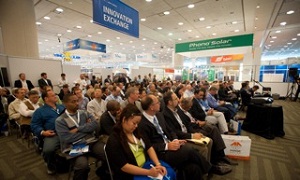Intersolar calls for transatlantic cooperation, part 2
 That the U.S. is no longer the world’s top solar country is not news. Its efforts to reclaim that title are best embodied by the DOE’s SunShot Initiative. Ramamoorty is leading that effort through an array of projects.
That the U.S. is no longer the world’s top solar country is not news. Its efforts to reclaim that title are best embodied by the DOE’s SunShot Initiative. Ramamoorty is leading that effort through an array of projects.
“The original name for this program was the ‘Dollar-A-Watt’ program. A lot of people thought it was too tech-y. And we said, ‘OK, we will back off, we will make it more like Sleepless in Seattle, very romantic.’ Therefore, we have this notion of the SunShot,” Ramamoorty said.
It’s based on Kennedy’s Moonshot Initiative, which launched the U.S. to the moon, after the Soviet Union jumped ahead in the space race with Sputnik.
“Thus we call this our Sputnik moment because something really hit us in the face,” he said.
In 1995, the U.S. had about 40 percent to 45 percent of the global market share of solar, according to Ramamoorty. Since then, it fell to about 6 percent of the global market.
“How does one get back onto the horse and be more competitive? We have a plan,” he said.
The dollar a watt figure consists of about 50 cents per watt for the modules themselves, which Ramamoorty called reasonable, but also for the balance-of-system costs to drop to 40 cents per installed watt.
“Which in this country is a very interesting challenge. Something that nobody’s attempted before, and we are looking at it,” he said.
To address such costs, which includes local permitting costs, SunShot is asking cities to come up with streamlined, less expensive, quicker means of permitting solar so it is deployed faster, Ramamoorty said.
“We’re challenging every city,” he said,” every jurisdiction to come forward with new protocols to implement solar.”
Since the U.S. uses 15 percent of the electricity produced in the world, the solar sales and manufacturing business is potentially a trillion dollar business domestically, Ramamoorty said.
“So we can't afford to get away from this. Competitiveness and creating jobs as a consequence is a very important component for us,” he said.
The U.S. has a successful solar venture capital market, according to Ramamoorty. And the Photovoltaic Incubator program has been very successful. But, the U.S. is still lacking in bringing companies from those initial stages to commercializing them.
“If you don't invest in complete manufacturing, you can lose the [industry],” he said.
When U.S. companies are ready to become manufacturers at scale, they can’t find attractive financing options. The U.S. can’t directly support that transition, but it can use its influence and support to help, according to Ramamoorty.
That’s resulted in programs like the DOE Loan Guarantee program.
“We believe this is the Apollo mission of our time. We would like to have subsidy free electricity. In this country we have subsidies for everything—take a left turn you have a 30 percent subsidy; do this you have another subsidy. We want to get to where solar electricity is at approximately five to six cents per kilowatt hour,” he said.
That’s comparable to fossil fuel without any subsidies.



